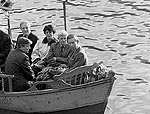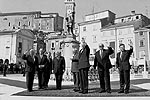What creates the image of a country and its citizens in the eyes of other people, of the world? Slovenia is a country that many people in the outside world have never heard of. It remains for many a stranger and, accordingly, a possibility for discovery and revelation. In 1991, Slovenia appeared on the European and the world map as a detail, often so tiny that there was not even enough place to write its name and the capital. We all know, however, that very often, the essence is in details and impressions that still need to be put together, if we want to grasp and understand the whole. Despite globalisation, today's world cannot be embraced by a single gaze, nor be seen as one totality, subject to a uniform and standardised understanding. So this world, for everyone, is full of impressions that enter our horizon and consciousness often quite accidentally, through the communication media, which allow ever faster transfers and links, through the media which supply us with copies of images and blow-ups, through computers feeding us with information. Which are we going to pick up? Which of those will be impressed on our memory? Which are those that we return to in order to renew and upgrade them? We are therefore presenting here some events, personalities, and facts, not related to each other, from completely different spheres of our experiences and adventures. When you try somehow to link the particles of the 'figurative images' which are spread before you, you might see that Slovenia is a country with a lively, contemporary and penetrating pulse, which is worth getting to know a little better, getting acquainted with. To see with your own eyes that even the small can bring much to our common world and life. The Slovene film Kruh in mleko (Bread and Milk) written and directed by Jan Cvitkovic has received the Golden Lion of the future - an award conferred for the best first feature film - at the 58th Venice Film Festival this year. Bread and Milk is the first Slovene film to be screened at the festival in 36 years. Cvitkovic was born in 1966 and graduated from archaeology. Although Bread and Milk is his debut in filmmaking, Cvitkovic has been involved in the film industry for a while now, establishing himself as a scriptwriter and an actor. In May 2001, the American and the Russian Presidents chose Slovenia
as the offsetting for their first meeting. The American-Russian summit
took place on 16 June at Brdo pri Kranju, which was an excellent
occasion for the promotion of our country.
The Slovenian architect and sculptor Marjetica Potrc has succeeded in making a break-through into international artistic circles. As a winner of the significant Hugo Boss Prize 2000, she recently opened a solo exhibition in the Guggenheim Museum in New York. At the Olympic games in Sydney in 2000, our sportsmen succeeded in
winning two gold medals, in rowing and shooting. In the "Slovenian
House" in York Street in Sydney, Slovenia made a very successful
presentation to both the Australian and the world public.
On 7 October 2000, Davo Karnicar, was the first person in the world to make a uninterrupted downhill ski descent from the world's highest mountain, the 8848 metres high Mount Everest. From June to September 2000, Ljubljana hosted the European Biannual of Contemporary Art Manifesta 3. In 1999, Slovenia hosted eminent personalities: on 21 and 22 June, US President W.J. Clinton made a visit, and on 19 September, Pope John Paul II visited our country for the second time. The alpinist exploit of Tomaz Humar echoed resounded round the world. In November 1999 he succeeded in scaling the Southern Wall of Dhaulaghiri in a solo climb. In 1998, Slovenia had its first presentation at the World Exhibition EXPO in Lisbon. The presentation was a success, with the Slovenian pavilion being visited by over a million guests. The Prince of Wales paid us a visit in the autumn of 1998.
On 12 November, the Slovenian and the international sporting public
marked a significant jubilee - Leon Stukelj's 100th birthday
(1898-2000), at that time the oldest living Olympian champion in the
world.
In June 1997, Slovenia hosted the Presidents of Central European
states in Piran.
During its year's presidency of CEFTA, Slovenia prepared a meeting of CEFTA Prime Minist ers in Portorozin September 1997. Ljubljana hosted the "European Month of Culture" in May and June 1997. Slovenia was visited by the Pope for the first time in 1996 when we
celebrated the fifth anniversary of the Slovenian independence.
The archaeological discovery of the "Neanderthal flute", the oldest
musical instrument in the world, at the site Divje Babe in 1995
attracted the attention of the global public.
Slovenia joined the celebrations marking the 50th anniversary of the victory over fascism, which took place throughout Europe. The emerging field of digital media arts has its own eco-system and the development of this particular art direction in global scale was partly enabled through the work of Marko Peljhan and Vuk Cosic.
Vuk Cosic is one of the so-called classics of "net.art". Since 1995, he has been included in all major international web art projects. He is one of the co-founders of the Ljubljana Laboratory for Digital Media (Ljudmila), the international fora for internet theory and critic, and the internet art Nettime, Syndicate, 7-11. Lately, he represented Slovenia at the Venice Biennial in 2001. The Group Laibach which has been performing since 1980, is well-known by its numerous concerts world-wide. The Czech ambassador to Slovenia, H. E. Jana Hybaskova who is leaving Slovenia after four years, said in a recent interview that her first acquaintance with Slovenian art was through the Group Laibach. The Group is still active and is continues to produce new albums. Zoran Music, an internationally highly-acclaimed Slovenian painter, works in Paris and Venice. Among musical performers, the pianist Dubravka Tomsic, the flute player Irena Grafenauer and the mezzo-soprano Marjana Lipovsek, all of whom perform mainly abroad, have received the highest world acclaim. The painters from the group Irwin accomplished an international reputation long ago. Their work is presented in all relevant overviews of contemporary art in the world. The works of art of the Slovenian architect Jozef Plecnik (1872-) with the large retrospective exhibition in Paris in the eighties, became a revelation both for Europe and the world as a whole. The exhibition moved from Paris to Ljubljana and then on to Madrid, Vienna, Munich, Karlsruhe, Milan, Venice, New York, and Washington. The Center Georges Pompidou in Paris, which prepared the exhibition with the help of the Architectural Museum Ljubljana, donated Plecnik's exhibition to Ljubljana. The exhibition in Prague (1997) presented his entire work from the Prague period when he was appointed chief architect to renovate the Prague Castle Hradcani. Slavoj Zizek is one of the best-known Slovene philosophers. He is the author of numerous books that have been reprinted several times in English and has been translated into numerous foreign languages. Slavoj Zizek lectures throughout American and other universities around the world. |









